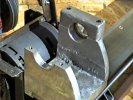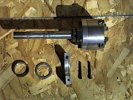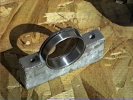
The first question you need to ask is will you be using bronze bushings or bearings to support your spindle? If you are building per Gingery's plans, then bushings are easily available at the hardware store. In my case, I opted for a larger, hollow spindle. I used a piece of CRS pipe, 1" O.D. and 5/8" I.D. This will allow me to work with some fairly large threaded rod. Of course I would then need to special-order the bushings. I found the solution at the auto-parts store. Standard trailer bearings which have a 1" I.D. and have a tapered outer race. The taper allows for sideways thrust, which will be generated during facing operations on the lathe.

From left to right, we have the bearing race, the retaining washer, one of the topcaps, and the mounting bolts for the topcap.
The original plan was to simply cast under-sized holes in the headstock, then bore then to size for the outer bearing race to slide in to. I planned to only bore part way through the topcaps so there would be a shoulder that the races would seat against. If I had bored my headstock the Gingery way, this would have been easy, but alas when you have a high quality end-mill at your disposal, plans change...
In the full size picture you can see a track cut into the bearing surface of the topcap. This required a hand-ground bit and a lot of patience to cut out. The end result, however, is that I now have a slot that the retaining washer sits in and assures that the topcaps auto-aligns itself during reassembly. The washer also provides a seat for the bearing race to push against.
